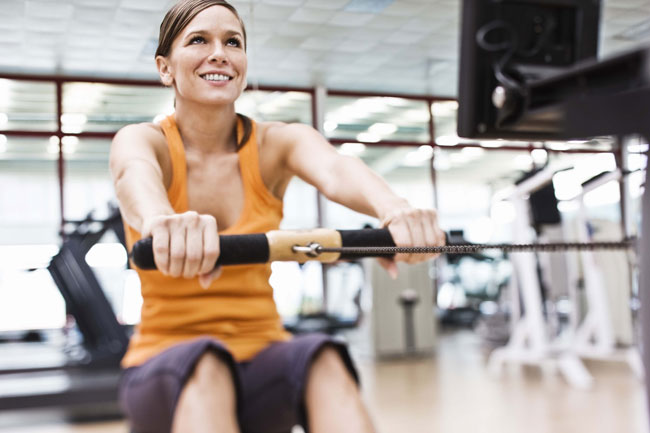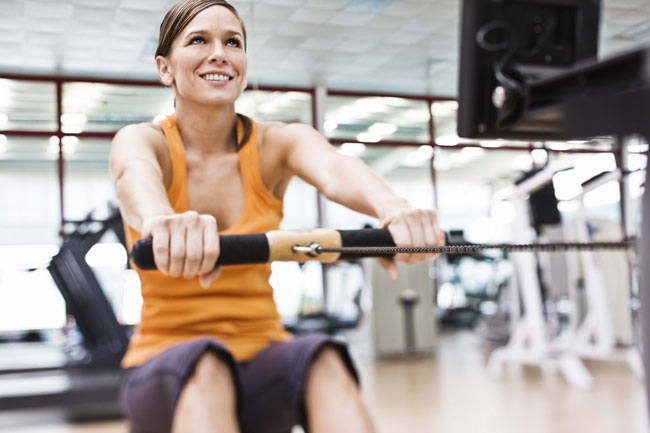
The most common weight apparatus in a gym is called a multi-station machine. It consists of a strong metal framework, pulleys, handles, seats, ankle cuffs, and adjustable iron weights. Plates are stacked one on top of the other with holes in the sides. To adjust the amount you want to lift, slide a metal pin into the desired hole. When you pull or lift, you are moving the selected stack. Some brands are labeled with clearly illustrated instructions for setting up each machine.
The following chart outlines 10 terrific exercises for weight machines. There are many more exercises and refinements, but these are among the most common that you can expect to be able to do in most weight rooms. As you look at the third column, “Position and Action,” keep in mind that no two brands of weight machines are exactly alike. Even different models or vintages of the same brand may be designed and function slightly differently. Therefore, some of the movements may vary. If you have any questions, ask a weight-room attendant for help or set up a how-to session with a trainer to get you started correctly.
| Machine or station | Muscle or Muscle Group | Position and Action | Function | Form |
Leg Curl |
Hamstrings(back of thighs) | Lying: While lying face down, hook your ankles behind a padded bar, press your hips down, and bend your knees to bring your heels toward your buttocks. Straighten your legs to return to the starting position. Seated: While seated, hook your ankles behind a padded bar and lift your lower legs until they are parallel to the floor. Bend your legs to the starting position. | Climbing stairs and hills | A shapely behind |
Leg Press |
Quadriceps and gluteals (front of thighs andbuttocks) | While lying on your back with your knees bent, place your feet against a pad and push your legs forward and up, stopping a few degrees short of the straightest possible extension. Bend your knees to return to the starting position. | Jumping, squatting or lifting heavy objects from the floor | A firm and toned lowerbody |
Triceps Press |
Triceps (back of the upper arms) | While seated, grasp the handles at your sides with your elbows bent and straighten your arms, pressing downward and back. Bend your elbows and return to the starting position. | Pushing up from an armchair | Toned triceps that eliminate flapping upper arms, especially in women |
Arm or BicepsCurl |
Biceps (front of upper arms) | While seated with your arms in front of you, grasp the handles and pull them up toward your shoulders, bending at the elbows. On some machines, you stand with your arms lowered in front of you, grasp the handles, and pull them up toward your chest, bending at the elbows. Straighten your elbows to return to the starting position. | Carrying a baby or a toddler, lifting and carrying heavy objects | Sculpted biceps-one of the classic muscles that shows muscle mass |
Chest Fly |
Pectorals (chest) | While seated, raise your forearms to chest level, place them behind padded panels or grip padded handles, and press them together in front of you. On some machines, you lie on your back and grasp handles above your chest, extend your arms out to your sides, and bring them up above your chest. Return to the starting position. | Pushing heavy objects, playing racquet sports | For men, a sculpted chest; for women, breasts appear firmer and sometimes larger |
Shoulder Press |
Deltoids (shoulders) | While seated, grasp the handles at chest or shoulder level and push them straight up. On some machines, you sit leaning forward slightly. Lower your arms to return to the starting position. | Lifting heavy objects | Well developed shoulders that make your waist appear narrower |
Upright Row |
Trapezius, deltoids, rhomboids, and biceps (shoulders and upper arms) | While standing with your arms extended in front of your hips, grasp the handles and – bending and raising the elbows – pull them back and up to shoulder level. Lower your arms to return to the starting position. | Carrying heavy objects, rowing or padding | Broad shoulders that make your waist appear narrower |
Chest Press |
Pectorals (chest) | While seated, grasp the handles in front of you at chest level and push them away from your body. Bend your elbows to return to the starting position. | Pushing heavy objects | Breast appear firmer and sometimes larger |
Seated Row |
Latissimi dorsi, trapezius, rhomboids, biceps, and erector spinea (back) | While seated with your legs bent, grasp the handles in front of you and pull them back, bending the elbows, as if rowing a boat. Return to the starting position. | Pushing heavy objects, helpingposture, rowing and paddling | Pulling, lifting, standing, an sitting erect |
Lat Pulldown |
Latissimi dorsi (back) | While seated, grasp the overhead bar and pull it down in front of your body to chest level, leaning back slightly. The weights will pull your arms upward to return to the starting position. | Lifting and pulling heavy objects,swimming | Well developed lats that make your hips appear narrower |
Note: Before you begin each exercise, adjust the seat for your height (if there is an adjustment) and the weight stack for your program. Then begin lifting, pulling, or pressing, depending on the exercise. Try to stay in control throughout the exercise, lifting and releasing evenly and smoothly.

